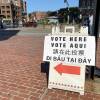Some of the races being decided in Tuesday’s state primary could be “very close,” but Massachusetts is unlikely to break turnout records, the state’s top elections official said.
Making his traditional pre-election projections, Secretary of State Bill Galvin said Thursday that he’s anticipating a primary turnout of 800,000 to 850,000 voters on the Democratic side and "in excess of 300,000" on the Republican side. If those numbers are correct, just under a quarter of the state's 4.8 milion registered voters will cast ballots.
“You have these intense contests on both sides, both the Democratic and Republican side, and I think that's going to bring out a pretty good vote,” Galvin told reporters.
Republican voters will pick between former state Rep. Geoff Diehl and political newcomer Chris Doughty as their party's nominee for governor. Across the aisle, Attorney General Maura Healey is the presumptive Democratic nominee for governor after Sen. Sonia Chang-Díaz dropped out of the race, though both women's names will appear on the ballot.
Voters in both parties will select a lieutenant governor nominee, and the Democratic ballot also features contests for attorney general, auditor and secretary of state — Galvin is running for reelection against challenger Tanisha Sullivan.
Four years ago, in the last election where the governor's office was on the ballot, more than 700,000 votes were cast on the Democratic side and about 278,000 voters participated on the Republican side. In 2020, when vote-by-mail options were offered as a COVID-19 adjustment, 1.4 million Democratic ballots were cast, and Galvin said turnout was "very low" on the Republican side without major contested races.
Most of Massachusetts 4.8 million registered voters are unenrolled — in other words, independents. Galvin said increased participation in primaries and voters’ exit from political parties have emerged as a trend across recent elections.
He said enrollment in the Republican party is "stagnant" at around 10 percent, and Democrats have seen their numbers "declining significantly," now below 30 percent. Unenrolled voters, who can choose a Democrat or Republican ballot, make up more than 60 percent of the electorate, and Galvin said they could play a key role in the outcomes of both parties' primaries.
"The decline in party enrollment is pretty pronounced, so it's encouraging that these people who are unenrolled still choose to participate in the primaries, which they can," Galvin said. "They do not become party members by voting in the primaries, and they know that."
Polls will be open statewide from 7 a.m. to 8 p.m. on Tuesday, and voters can find their polling places online on Galvin’s website. Some voting locations and precincts shifted after state lawmakers redrew the legislative maps last year.
The Sept. 6 primary is the first statewide election since the passage of a new law this year that made permanent the expanded mail-in and early voting options introduced at the height of the pandemic.
Galvin said more than 576,000 Democratic ballots and 124,000 Republican ballots were mailed out. More than half of the people who requested mail-in ballots were independent voters. Galvin said more than 22 percent asked for Republican ballots, a figure he said could be "politically significant."
With primary day now so close, Galvin's office is recommending that people no longer return ballots by mail but instead bring them to a local election office or use a dropbox set up by their city or town to ensure it is counted. Ballots must be returned by 8 p.m. Tuesday.
"It cannot be brought back to the polling place on Tuesday," Galvin said. "But it's very important if they want to get that ballot in — and we believe that literally hundreds of thousands of ballots are still out there — that they take it to a dropbox.”
So far, almost 285,000 Democratic ballots and almost 60,000 Republican ballots have been returned, Galvin said. Almost 24,000 Democrats and about 7,600 Republicans have voted early in-person. Voters can find early in-person polling locations online.
Mail-in votes are pre-processed so that local officials can be ready to tabulate them after polls close, Galvin said. He said he’s optimistic results will be known Tuesday night.
“You may have some very close races,” he said. “Certainly, if you believe some of the published polling, some of these races are very, very close, and so that may be a delay in terms of knowing the final number. We will certainly have significant numbers on Tuesday night.”








